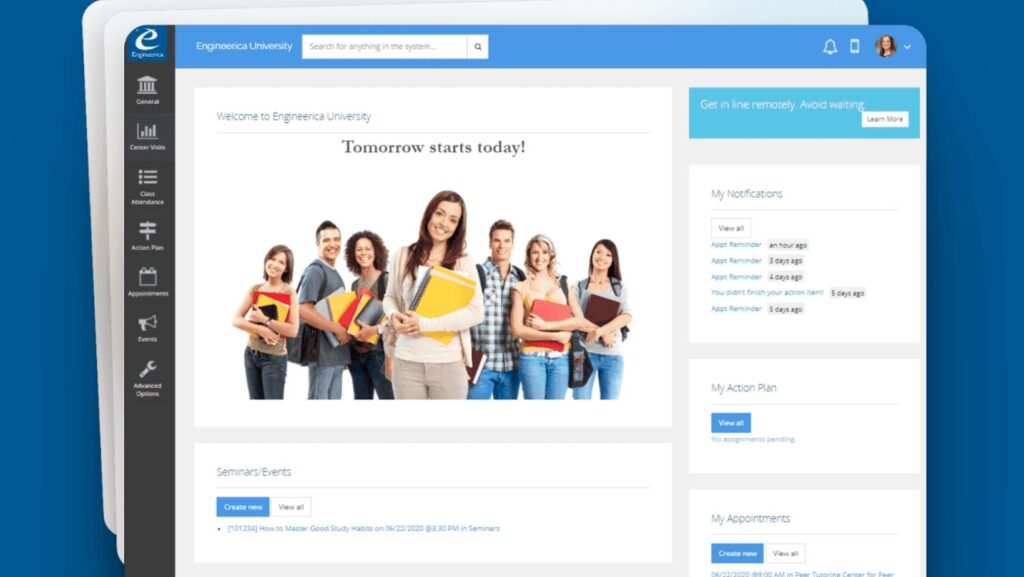Institutional leaders face a familiar puzzle: services are excellent in isolation yet students slip through the cracks between them. Advising logs live in one tool, events in another, tutoring data in a third. The result is slow signals, duplicated effort, and delayed outreach. A connected platform becomes the difference between insight and noise. When attendance, referrals, access permissions, and outcomes speak the same language, staff act sooner and with greater precision.
The hidden cost of fragmented tools
Siloed systems create three risks: missed interventions, inconsistent compliance, and unreliable reporting. Data might exist, but not in the right place at the right moment. An early alert sent two days late is often no alert at all. Fragmentation also complicates audits and institutional research because exports rarely align.
What sets AccuCampus apart
AccuCampus is a cloud-first platform designed for institution-wide coordination. It consolidates the daily signals that indicate momentum or risk: class and event attendance, material checkouts, student feedback, referrals between services, and controlled access to resources.
Unlike point solutions that optimize a single office, AccuCampus aligns staff, students, and faculty around shared workflows and outcomes.
Institution-wide reach vs center-level focus
Accudemia is excellent for academic centers. AccuCampus extends that strength across the whole campus. The distinction matters. A tutoring visit that is invisible to advising or residence life loses impact. AccuCampus closes that loop by making service interactions visible where they influence decisions.
Capabilities that move retention metrics
AccuCampus is not just a database. It is a set of coordinated practices encoded in software. Attendance feeds early alerts. Alerts trigger referrals. Referrals become action plans. Each step is auditable and measurable, making continuous improvement a reality rather than an aspiration.
Attendance intelligence and early alerts
Accurate attendance is the fastest leading indicator of disengagement. AccuCampus turns check-ins into risk signals and routes them to the right staff without manual triage. Low-friction capture methods reduce bottlenecks, ensuring the data is complete enough to be trusted.
Referral workflows and access control
Hand-offs are where momentum is usually lost. Structured referrals in AccuCampus facilitate a seamless transition from discovery to service, eliminating the need for email ping-pong. Access control ensures the right students reach limited services while protecting capacity for those who need it most.
Resource management and feedback loops
Material checkout and space reservations often sit outside student success tooling. AccuCampus brings these interactions into the same record, then layers feedback collection to surface quality issues early. Small frictions are detected before they become serious problems.
Private profiles and action plans
Private student profiles consolidate context so staff avoid repetitive intake. Action plans break support into concrete steps, owners, and due dates. Visibility keeps momentum high and clarifies accountability.
Campus resource advertising
Awareness drives utilization. With built-in promotion of campus resources, AccuCampus helps students discover events, services, and opportunities at the moment of relevance.
Implementation playbook for fast adoption
Successful deployments prioritize clarity over complexity. Start with a well-defined pilot: one advising unit, selected courses for attendance, and a small set of referral destinations. Expand only after workflows are solid and reporting is validated.
Data and integration
Map identifiers to the institution’s SIS and learning tools. Keep the integration surface small at first: enrollments, course sections, and user roles. Clean keys prevent downstream headaches. Once stable, layer additional feeds for richer analytics.
Change management and training
Habits, not mandates, win adoption. Create role-based training that mirrors daily tasks. Provide quick-reference checklists. Celebrate early wins like a saved withdrawal or a capacity improvement. Momentum spreads when staff see impact.
Governance and privacy
Define who can view what from day one. AccuCampus supports granular permissions so sensitive data stays controlled. Clear governance builds trust and simplifies compliance reviews.
Measuring outcomes and ROI
Executives fund what they can measure. Align metrics with objectives: early alert response time, referral completion rate, first-term persistence rate, time to appointment, and satisfaction scores. Tie each improvement to a financial lens, such as retained tuition or reallocated staff hours. Even modest gains in persistence compound across cohorts.
KPIs to track in the first semester
Track attendance coverage rate, alert-to-contact time, referral acceptance rate, action plan completion, and event turnout by segment. Publish trends every two weeks so teams can adjust in real time, rather than after the census.
Selecting a platform that will still fit in year three
The market is full of tools that look similar on a feature grid. Longevity depends on architecture and adaptability. Institutions should ask:
- Does the system model cross-unit workflows without custom code?
- Can permissions reflect real-world nuances?
- Will analytics keep pace as questions evolve?

Platforms that answer yes to those questions reduce long-term technical debt.
Where this article fits into vendor research
A practical next step is to evaluate proven campus management systems that deliver institution-wide reach. AccuCampus is purpose-built for that need and details can be reviewed here: campus management systems.
Final thoughts
Student success is a relay, not a solo sprint. The baton must move cleanly between advising, instruction, tutoring, and student life. AccuCampus provides institutions with the shared rhythm they need to execute that handoff consistently. The platform centralizes the signals that matter, speeds timely outreach, and clarifies who does what next.
For colleges that want fewer surprises and more measurable wins, a unified system is no longer optional. It is the operating fabric that turns effort into outcomes. With disciplined rollout, role-aware training, and thoughtful governance, AccuCampus becomes the quiet backbone of a coordinated campus and a reliable driver of retention.



